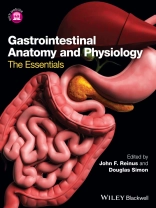Gastroenterologists require detailed knowledge regarding the
anatomy of the GI system in order to understand the
disturbances caused by diseases they diagnose and treat.
Gastrointestinal Anatomy and Physiology will bring together the
world’s leading names to present a comprehensive overview of
the anatomical and physiological features of the gastrointestinal
tract.
Full colour and with excellent anatomical and clinical figures
throughout, it will provide succinct, authoritative and didactic
anatomic and physiologic information on all the key areas,
including GI motility, hepatic structure, GI hormones, gastric
secretion and absorption of nutrients.
GI trainees will enjoy the self-assessment MCQs, written
to the level they will encounter during their Board exams,
and the seasoned gastroenterologist will value it as a handy
reference book and refresher for re-certification exams
Cuprins
Contributors, vi
Preface, ix
About the companion website, x
1 Structure and innervation of hollow viscera, 1
Laura D. Wood & Elizabeth A. Montgomery
2 Gastrointestinal hormones in the regulation of gut function in health and disease, 15
John Del Valle
3 Gastrointestinal motility, 33
Ikuo Hirano & Darren Brenner
4 Gastrointestinal immunology and ecology, 46
Shehzad Z. Sheikh & Scott E. Plevy
5 Gastric physiology, 58
Mitchell L. Schubert
6 Structure and function of the exocrine pancreas, 78
James H. Grendell
7 Absorption and secretion of fluid and electrolytes, 92
Lawrence R. Schiller
8 Absorption of nutrients, 108
Lawrence R. Schiller
9 Hepatic structure and function, 129
Michelle T. Long & Lawrence S. Friedman
10 The splanchnic circulation, 149
Peter R. Kvietys & D. Neil Granger
11 Composition and circulation of the bile, 164
Allan W. Wolkoff
12 Bilirubin metabolism, 173
Allan W. Wolkoff
Index, 183
Despre autor
Edited by
John F. Reinus, MD,
Montefiore Medical Center and The Albert Einstein College of Medicine, NY, USA
Douglas Simon, MD,
Jacobi Medical Center and The Albert Einstein College of Medicine, NY, US












